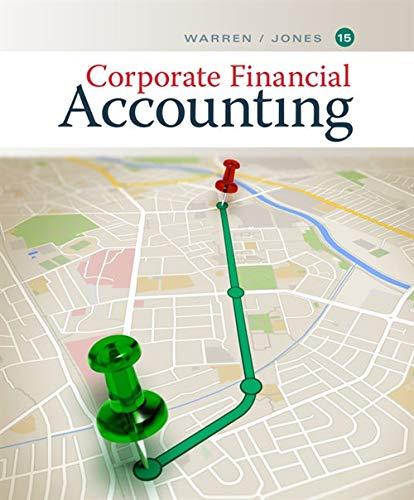Question
Hello sir/ ma'am This is where i am getting started. find the questions below 1 Okafor Company has five products in its inventory. Information about
Hello sir/ ma'am
This is where i am getting started. find the questions below
1 Okafor Company has five products in its inventory. Information about the December 31, 2018, inventory follows.
Product
Quantity
Unit
Cost
Unit
Replacement
Cost
Unit
Selling
Price
A
900
$
23
$
25
$
29
B
500
28
24
31
C
700
16
15
21
D
1,000
20
17
19
E
700
27
25
26
The cost to sell for each product consists of a 15 percent sales commission. The normal profit percentage for each product is 35 percent of the selling price.
Required:
1. Determine the carrying value of inventory at December 31, 2018, assuming the lower of cost or market (LCM) rule is applied to individual products.
2a.Determine the carrying value of inventory at December 31, 2018, assuming the LCM rule is applied to the entire inventory.
2b. Assuming inventory write-downs are usual business practice for Forester, record any necessary year-end adjusting entry.
2 Amaobi Stop sells two product categories, furniture and accessories. Information pertaining to its 2018 year-end inventory is as follows:
Inventory,
by Product Category
Quantity
Per Unit
Cost
Market
Furniture:
Chairs
80
$
41
$
47
Desks
70
89
74
Tables
30
100
108
Accessories:
Rugs
80
76
64
Lamps
60
38
34
Required:
1. Determine the carrying value of inventory at year-end, assuming the lower of cost or market (LCM) rule is applied to (a) individual products, (b) product categories, and (c) total inventory.
2. Assuming that the company reports an inventory write-down as a line item in the income statement, for each of the LCM applications determine the amount of the loss.
3 Uchenna Company maintains inventory records at selling prices as well as at cost. For 2018, the records indicate the following data:
($ in 000s)
Cost
Retail
Beginning inventory
$
87
$
145
Purchases
791
1,037
Freight-in on purchases
34
Purchase returns
1
3
Net markups
5
Net markdowns
9
Net sales
920
Required:
Assuming the price level increased from 1 at January 1 to 1.30 at December 31, 2018, use the dollar-value LIFO retail method to approximate cost of ending inventory and cost of goods sold. (Do not round intermediate calculations. Round final answers to the nearest whole dollar. Enter your answers in thousands.)
Estimated ending inventory at retail
Estimate ending inventory at cost
Estimate cost of goods sold
4 Uzodinma Company sells its products to customers on a credit basis. An adjusting entry for bad debt expense is recorded only at December 31, the company's fiscal year-end. The 2017 balance sheet disclosed the following:
Current assets:
Receivables, net of allowance for uncollectible accounts of $44,000
$
502,000
During 2018, credit sales were $1,820,000, cash collections from customers $1,900,000, and $53,000 in accounts receivable were written off. In addition, $4,400 was collected from a customer whose account was written off in 2017. An aging of accounts receivable at December 31, 2018, reveals the following:
Percentage of Year-End
Percent
Age Group
Receivables in Group
Uncollectible
0-60 days
65
%
4
%
61-90 days
15
10
91-120 days
15
30
Over 120 days
5
50
Required:
1. Prepare summary journal entries to account for the 2018 write-offs and the collection of the receivable previously written off.
2. Prepare the year-end adjusting entry for bad debts according to each of the following situations:
- Bad debt expense is estimated to be 3% of credit sales for the year.
- Bad debt expense is estimated by computing net realizable value of the receivables. The allowance for uncollectible accounts is estimated to be 10% of the year-end balance in accounts receivable.
- Bad debt expense is estimated by computing net realizable value of the receivables. The allowance for uncollectible accounts is determined by an aging of accounts receivable.
3. For situations (a)-(c) in requirement 2 above, what would be the net amount of accounts receivable reported in the 2018 balance sheet?
5 Chibuzo , Inc., manufactures premium gas barbecue grills. The company uses a periodic inventory system and the LIFO cost method for its grill inventory. Cast Iron's December 31, 2018, fiscal year-end inventory consisted of the following (listed in chronological order of acquisition):
Units
Unit Cost
5,600
$
400
4,300
500
6,600
600
The replacement cost of the grills throughout 2019 was $700. Cast Iron sold 30,000 grills during 2019. The company's selling price is set at 200% of the current replacement cost.
Required:
1. & 2. Compute the gross profit (sales minus cost of goods sold) and the gross profit ratio for 2019 under two different assumptions. First, that Cast Iron purchased 31,000 units and, second, that Cast Iron purchased 16,500 units during the year.
4. Compute the gross profit (sales minus cost of goods sold) and the gross profit ratio for 2019 assuming that Cast Iron purchased 31,000 units (as per the first assumption) and 16,500 units (as per the second assumption) during the year and uses the FIFO inventory cost method rather than the LIFO method.
Compute the gross profit (sales minus cost of goods sold) and the gross profit ratio for 2019 assuming that Cast Iron purchased 31,000 units (as per the first assumption) and 16,500 units (as per the second assumption) during the year and uses the FIFO inventory cost method rather than the LIFO method.(Round "Gross profit ratio" answer to 1 decimal place (i.e., 0.123 needs to be entered as 12.3%.))
Thank you
Joy
Step by Step Solution
There are 3 Steps involved in it
Step: 1

Get Instant Access to Expert-Tailored Solutions
See step-by-step solutions with expert insights and AI powered tools for academic success
Step: 2

Step: 3

Ace Your Homework with AI
Get the answers you need in no time with our AI-driven, step-by-step assistance
Get Started


